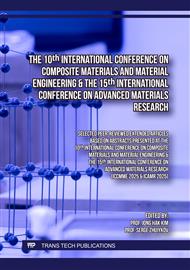[1]
Lopez, E. C. R., & Perez, J. V. D. (2023). PAN/PVP/CD-MOF composite beads for the removal of Crystal Violet and Brilliant Blue G in water. Materials Today: Proceedings.
DOI: 10.1016/j.matpr.2023.09.178
Google Scholar
[2]
Seker, S., & Karaaslan Ayhan, N. (2023). Adsorption potential of neodymium/alginate beads for removal of Congo red and Brilliant blue G from aqueous solution. International Journal of Environmental Science and Technology, 20(7), 7293–7304.
DOI: 10.1007/s13762-023-04794-z
Google Scholar
[3]
Panghulan, G. R., Vasquez, M. R., Jr., Edañol, Y. D., Chanlek, N., & Payawan, L. M., Jr. (2020). Synthesis of TiN/N-doped TiO₂ composite films as visible light active photocatalyst. Journal of Vacuum Science & Technology B, 38(6), 62203.
DOI: 10.1116/6.0000304
Google Scholar
[4]
Buenviaje, S. C., Jr., Edañol, Y. D. G., Legaspi, E. D. R., Payawan, L. M., Jr., & Usman, K. A. S. (2021). One-pot synthesis of redispersible polymer-stabilized ZnO nanocomposites. Philippine Journal of Science, 150.
DOI: 10.56899/150.6a.07
Google Scholar
[5]
Buenviaje, S. C. J., Usman, K. A. S., Edañol, Y. D. G., Maylem, G. P., & Payawan, L. M., Jr. (2020). One-pot photochemical synthesis of solution-stable TiO₂-polypyrrole nanocomposite for the photodegradation of methyl orange. Key Engineering Materials, 853, 217–222.
DOI: 10.4028/www.scientific.net/kem.853.217
Google Scholar
[6]
Sisican, K. M. D., Usman, K. A. S., Bacal, C. J. O., Edañol, Y. D. G., & Conato, M. T. (2023). Benzoic acid modulation of MIL-88B(Fe) nanocrystals toward tunable synthesis of MOF-based Fenton-like degradation catalysts. Crystal Growth & Design, 23(12), 8509–8517.
DOI: 10.1021/acs.cgd.3c00266
Google Scholar
[7]
Merca, S. M. O., et al. (2024). Tuned photodegradation efficiency of bimetallic copper-iron oxide catalysts via precursor stoichiometry control for water decontamination. Advanced Science and Technology, 151, 25–31.
DOI: 10.4028/p-umwd6s
Google Scholar
[8]
Weng, B., Qi, M.-Y., Han, C., Tang, Z.-R., & Xu, Y.-J. (2019). Photocorrosion inhibition of semiconductor-based photocatalysts: Basic principle, current development, and future perspective. ACS Catalysis, 9(5), 4642–4687.
DOI: 10.1021/acscatal.9b00313
Google Scholar
[9]
Rodwihok, C., et al. (2021). Improved photocatalytic activity of surface charge functionalized ZnO nanoparticles using aniline. Journal of Materials Science & Technology, 76, 1–10.
DOI: 10.1016/j.jmst.2020.09.041
Google Scholar
[10]
Masud, R. A., et al. (2020). Preparation of novel chitosan/poly(ethylene glycol)/ZnO bionanocomposite for wound healing application: Effect of gentamicin loading. Materialia, 12, 100785.
DOI: 10.1016/j.mtla.2020.100785
Google Scholar
[11]
Coussot, G., et al. (2011). A rapid and reversible colorimetric assay for the characterization of aminated solid surfaces. Analytical and Bioanalytical Chemistry, 399(3), 1061–1069.
DOI: 10.1007/s00216-010-4363-7
Google Scholar
[12]
Saif Al Essai, K. R., et al. (2024). Enhanced mitigation of acidic and basic dyes by ZnO-based nano-photocatalysis: Current applications and future perspectives. Environmental Geochemistry and Health, 46(4), 139.
DOI: 10.1007/s10653-024-01935-2
Google Scholar
[13]
Thatikayala, D., et al. (2020). Enhanced photocatalytic and antibacterial activity of ZnO/Ag nanostructure synthesized by Tamarindus indica pulp extract. Journal of Materials Science: Materials in Electronics, 31(7), 5324–5335.
DOI: 10.1007/s10854-020-03093-4
Google Scholar
[14]
Mohamed, Z. H., et al. (2023). Enhanced photocatalytic degradation of the antidepressant sertraline in aqueous solutions by zinc oxide nanoparticles. Water, 15(11).
DOI: 10.3390/w15112074
Google Scholar



